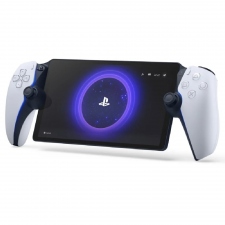Sony have just announced the PlayStation Portal, their new handheld console formerly teased as Project Q and set to retail for $199 (Euro and UK pricing and pre-order and release dates all TBC).
And that seems like a keen price… Until you consider exactly what Portal is, what it does and most importantly what it can't do.
So what is it?
It’s basically an eight-inch mobile phone screen with a DualSense joypad wrapped around it. There’s a WiFi connection, USB-C for charging, all the haptics, adaptive triggers and mic of the standalone DualSense… Built-in speakers… A battery… And that’s about it.
There’s no data connection (unlike their PlayStation Vita handheld) and no Bluetooth for headphones or headsets. Instead Portal features Sony’s proprietary PlayStation Link tech coined on the PS5 allowing connection to existing compatible PlayStation headsets and the new Pulse Explore earbuds and Pulse Elite headset announced alongside the unit.
Fortunately, if you don’t fancy shelling out a further $200 for these new earbuds or $150 for the new headset there’s an old-school 3.5mm headphone jack… Provided you’ve still got some wired headphones lying around.
The screen is LCD rather than OLED (something that will surprise Nintendo Switch lovers) and the sticks are actually lifted from the PSVR2 controller rather than the DualSense, despite their looks. There’s no DualSense touch pad but it’s replicated on the touchscreen (yes, Portal has a touchscreen) appearing as two ‘zones’ bottom left and right on the screen that appear when you outstretch your thumbs to find them.
What else is missing? Well, there’s no internal storage, no cart socket and no way to play a game independently of the PlayStation 5 console that it’s paired to. Portal features no online store, no means to download anything to it and - most importantly - no internal gaming ‘brains’ to speak of, meaning that there’s no store or downloads feature ‘coming soon’. Or ever. At least for this particular generation.
All of which places the Portal a world away from Sony’s previous portable games console such as their PlayStation Portable or PlayStation Vita handheld consoles.
We use the word portable loosely as Portal can only ever be tethered to your PS5 via a good WiFi connection and without one is totally useless.
So what IS it for?
It’s a way to play games from your PlayStation 5 on an alternative ‘portable’ screen. It’s a portal to your PS5. Hence the name. And that’s it. And we use the word portable loosely as Portal can only ever be tethered to your PS5 via a good WiFi connection and without one is totally useless.
In an ideal world this WiFi connection would be a local one and with the PS5 streaming over your home WiFi the tech inside the PS5 and Portal can optimise the flow of data at both ends to facilitate the fastest responses from the controls and the smoothest streaming of the graphics and sound back again.
But if streaming from one side of a room to the other sounds a bit pathetic, don’t worry, you can stream from your PS5 to any WiFi network so - in theory at least - anywhere where there’s a decent WiFi connection your Portal can find your PS5. And turning on Portal turns on your PS5 at home. Very neat.
But doesn’t Sony Remote Play - linking your PS5 to your phone via an app - do all this already? In a word, apart from that remote switch on, yes. Which rather begs the question ‘So what is this for?’ Well it’s certainly a simpler and faster way to connect to your PS5 than by using Remote Play - Portal literally does nothing else but this - and the hardware, screen and familiar DualSense-style controls are perfect for PS5 play. So much so that the cludge and ‘will it/wont it’ nature of Remote Play begins to look like a novelty rather than a workable reality. And the smart connection (at least on local WiFi) should be some improvement for framerate and response. As for further afield? We’ll have to wait for all those brutal real world tests.
So who is it for?
Short answer is that around now you’ll know whether this is for you or not. If you’re a Remote Play lover that wants something with all the feel and fidelity in one simple package (and potentially without all the glitches and dropouts) then this is perfect.
For everyone else the Portal will be a confusing entry into the mobile gaming market.
In fact, the Portal’s bespoke (and perhaps a little disappointing) abilities have drawn comparisons with Nintendo’s ill-fated Wii U console, their 2012 sequel to 2006’s smash-hit Wii. That console featured an impressive remote touchscreen controller that, despite its wholly portable looks, was forever doomed to remain within Bluetooth range of its under-the-TV brains.
The comparison is a little harsh. Portal goes much further than this - literally - but it remains to be seen just how magical the link works on your average bus-quality WiFi. And as for a means to stream a PlayStation subscription-based cloud gaming service without a PS5? This machine isn’t it.
But you can bet that one is one the way.






















